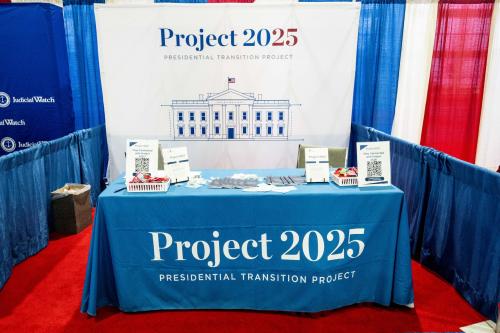President Trump, Project 2025, and red state governors are calling for turning federal programs into block grants to school districts as a critical part of their reform proposals—but many of these programs already are block grants. What changes are they really proposing, and what does research say about what they would mean for public schools?
State and national Republican leaders are talking about education block grants. Proponents of “block granting” federal education funds to districts argue eliminating the limits on how districts can spend the funds would provide more flexibility and potentially more productive uses of funds. The political right makes this point vocally at the national level, but the burdens of compliance are appreciated apolitically at the local level. Advocates on the left worry block granting is a strategy to reduce federal funds for schools.
This piece examines the current proposals for and political implications of block granting federal education funds.
In March, Iowa and Oklahoma requested waivers to receive their federal funds under the Elementary and Secondary Education Act (ESEA) in the form of a block grant; advocates note that under current law, such waivers would likely be illegal.
The president’s FY26 budget proposal, released May 30, would replace 18 federal programs collectively currently funded at $6.5 billion with a single, new $2 billion block grant called the “K-12 Simplified Funding Program.” (This program is not included in the One Big Beautiful Bill Act, which relates to FY25 spending.) Among the 18 programs are ones supporting homeless students, rural schools, and after-school activities. By combining them into a block grant, Congress would shift the discretion—and political challenge—of choosing what to keep or cut to states and districts. The budget proposal also suggested combining multiple special education funding streams (regulated through the Individuals with Disabilities Education Act, or IDEA) into one, and eliminating several programs, including nearly a billion dollars for English learner supports.
The budget proposal would maintain the biggest program, Title I of ESEA, outside the newly proposed Simplified Funding Program, holding funding steady at $18.4 billion. Though, notably, Project 2025 called for Title I to initially “be administered as a no-strings-attached formula block grant,” then, over a 10-year period, to “restore revenue responsibility to the states”—in other words, to eliminate federal funding for Title I.
Title I allocates funds to districts, which control how the money is spent, within program parameters. For example, as of now, a district could not use Title I “compensatory education” funds to support programming exclusively for their most academically advanced students, but it could use Title I funds to support a broad range of schoolwide programming (like a reading coach, a tutoring program, or professional development) in high-poverty schools. If Title I were to be transformed into a no-strings block grant, the funds legally could be entirely invested in facilities upgrades or programs in a district’s most affluent school. Indeed, the program’s early years in the 1960s saw segregated districts investing in all-white schools, ultimately leading to more federal restrictions in hopes of aligning the letter of the law with its compensatory spirit.
The conservative proposals pose core questions about federalism and public education. Should there be any federal role in financing public K-12 education, and if so, how much control over local education policymaking should come with it?
Both economic theory and public opinion suggest there should be a federal role in elementary and secondary education.
Under the theory of fiscal federalism, federal grants make sense because the benefits of educational investments—from a stronger workforce to an engaged citizenry— spill over across state lines. Most states guarantee the right to a public education in their state constitutions and regularly redirect state funds to support local school districts with less fiscal capacity or greater student needs. Similarly, fiscal capacity varies considerably across states, and Congress is uniquely positioned to support greater education spending in poorer states.
Public opinion overwhelmingly supports federal investment in K-12 education. An April 2025 national poll, for example, finds that 85% of parents support some federal role in “providing funding for schools serving low-income students” with nearly two-thirds supporting a major role.
In the 2019-20 school year (before the temporary infusion of COVID-19 relief funds), federal funds constituted over 12% of total elementary and secondary revenue in relatively poor, low-spending states like Mississippi and New Mexico, and less than half that in affluent states like Connecticut and New York. About half of federal funds for schools are administered by the Department of Education, with Title I and IDEA being the largest programs.
Even when federal funds are not substantial, the strings almost always are—and they can affect public schools and the students they serve.
In her March 19 opinion piece for The Hill, Iowa governor Kim Reynolds explained her state’s waiver request by arguing that the “bureaucratic strings” attached to federal education funds limit the ability of districts to spend them effectively. These strings and their reach can be hard to see for those not working in school systems, but they are substantial, and experts have been calling for a more reasonable system for decades.
Some strings are meant to promote fiscal and administrative accountability, and other strings act as policy incentives–or, depending on your perspective, coercion. Further, agencies receiving federal (education or other) funds must comply with the federal Civil Rights Act (CRA), and the Department of Education is responsible for determining what constitutes compliance with CRA for schools. Those terms can also act as strings on federal funds.
I’ll start with the least controversial: Congress wants fiscal oversight of allocated funds to prevent fraud and abuse. This is true of all federal grantees, not just education agencies, and a number of fiscal rules apply for all federal grants (for example, see this on time and effort rules).
Yet in practice, even the fiscal rules governing federal education grants are of limited use in promoting public accountability. Some fiscal rules are grant specific, often in confusing ways. For example, school districts must show they “supplement, not supplant” federal funds under one set of rules for Title I and a different set of rules—by the same name—for IDEA. The intent behind these specific rules is to ensure federal funding is supplementing state and local resources (rather than taking their place). In practice, it is hard to establish how states and localities would have allocated resources in the absence of Title I or IDEA, and the compliance environment can distort decisions of practice that matter for students.
For example, districts that pass an audit one year can almost certainly pass the next year if they do not change how they spend their funds. This risk-averse approach limits districts’ capacity to respond effectively to changing needs. I wrote about this issue when ESEA was most recently reauthorized, and as it relates to pandemic relief through the Elementary and Secondary School Emergency Relief (ESSER) program. Ultimately ESSER earned a reputation not only for its massive infusion of funds, but also for its “plandemic” of administrative burdens around planning and reporting.
Cleaning up fiscal rules (as opposed to just adding new ones) is hard, and not only because of bureaucratic complexity. There is a fundamental and longstanding political tension between Congress’ desire to support state and local flexibility in service of effective spending and civil rights advocates’ historically earned distrust that districts will spend money designated for certain student groups as intended. A lack of trust in the institutions running public schools is a major problem—but not one that these rules are going to resolve. It’s hard to write rules that concentrate funds solely on targeted students when those students might benefit most from spending that necessarily touches others in the district. And even when fiscal rules or guidance are changed, those changes do not easily filter through the organizational culture of state and local agencies.
Nonetheless, there should be plenty of bipartisan common ground here to do the hard work to reduce the compliance burden on districts and states while maintaining some checks against financial malfeasance. To succeed, the local leaders who implement these rules must be centrally involved from the start in any attempts to overhaul federal rules.
The U.S. Constitution does not delegate power over education to the federal government, reserving it for the states. This means the federal government cannot make school districts do things, but Congress can—and does—offer funds to states and school districts that are conditional on policy actions.
This can take the form of competitive grants, like Race to the Top, where only the entrants willing to propose policies most aligned with federal priorities “win” the funds. Formula-driven programs like Title I, where nearly all districts regularly participate, also make funding conditional on state or district policies. For example, Congress used Title I as a carrot to get states to adopt standards-aligned test-based accountability systems in No Child Left Behind.
All three branches of the federal government are involved in defining the conditions of federal funding. Congress writes the laws and authorizes the funds; the courts interpret the law as challenges arise; and the executive branch can weigh in through the regulatory process, non-binding policy guidance (such as “Dear Colleague” letters) that are not subject to notice and comment, or executive orders. (The Supreme Court’s reversal of Chevron limited federal agencies’ authority to interpret federal law, and may shift the balance toward a more substantial judicial role.)
Under recent presidential administrations, some of the highest profile—and most inconsistent— K-12 actions have been about civil rights, such as how to interpret sexual orientation and gender identity protections under Title IX. New administrations undo the actions of previous ones, leaving school districts and state education agencies to manage the policy churn. These are all “strings,” and they only have teeth because of federal funds. For example, when President Trump pushed Maine governor Janet Mills to comply with his executive order banning transgender students from participating in school sports, he explicitly told her, “Otherwise, you’re not getting any federal funding.”
“Strings” per se are not good or bad—they can make local policy better or worse, depending on where you stand on the policy questions and who is in power federally and locally. While the specific conditions for federal funding have varied over time, the use of these strings to influence state and local behavior is not limited to any party or branch–it’s simply the only way federal government can shape education policy in our federalist system, and those in power use it to promote their policy goals.
Governor Reynolds also argues that there are too many programs, yielding multiple small pots of money (and sets of strings) that are not conducive to high-impact, scalable work. This is what happens when advocates want to protect their desired spending area: They fight for a distinct revenue stream and corresponding financial reporting.
Our current approach puts significant administrative burden on schools to demonstrate compliance and is likely to distort decisions on how to best allocate funds. And while research evidence on how “money matters” for schools is widely cited in defending federal programs, that body of research was largely generated relying on changes in unrestricted state revenue to school districts—not from research adding up the impact of many small restricted pots of money.
The same set of considerations arise in designing the flow of state revenue to school districts. When it comes to advising states on school finance, education policy experts have coalesced around endorsing weights for students with characteristics related to higher instructional costs (e.g., students with disabilities and English learners), as opposed to having separate funding streams and programs for them all, to reduce complexity and enhance holistic programming. California’s Local Control Funding Formula is an example of this type of switch. This reasoning is sound, and could just as easily apply to federal funds.
There is broad agreement that the current funding system does not excel at serving those targeted for additional supports by these programs, despite the many strings attached (to be clear, though, it could be worse without these programs and the strings attached). But funding strings are blunt policy instruments imposed far from the classroom, where K-12 education is delivered. The upside is that the cost of loosening those strings may not be as great as advocates fear.
Advocates for public education should not walk away from this fight. They should dig in on protecting federal funds, but this does not necessarily mean defending every specific funding stream that currently exists. A shift from the current system—many programs with lots of strings—to a smaller set of flexible block grants could be beneficial, especially if overall funding levels are maintained or increased. Federal funding is especially important for lower-income districts in lower-income states, where local resources are often insufficient to meet students’ needs.
Finally, should block granting actually happen, supporters of public education should also help voters hold local and state leaders accountable for explaining their decisions in plain language, without attributing them to federal compliance demands. Federal compliance would no longer be a valid excuse for local leaders’ decisions—or their inertia.
The Brookings Institution is committed to quality, independence, and impact.
We are supported by a diverse array of funders. In line with our values and policies, each Brookings publication represents the sole views of its author(s).








Commentary
Block granting federal education funds comes with trade-offs
July 15, 2025